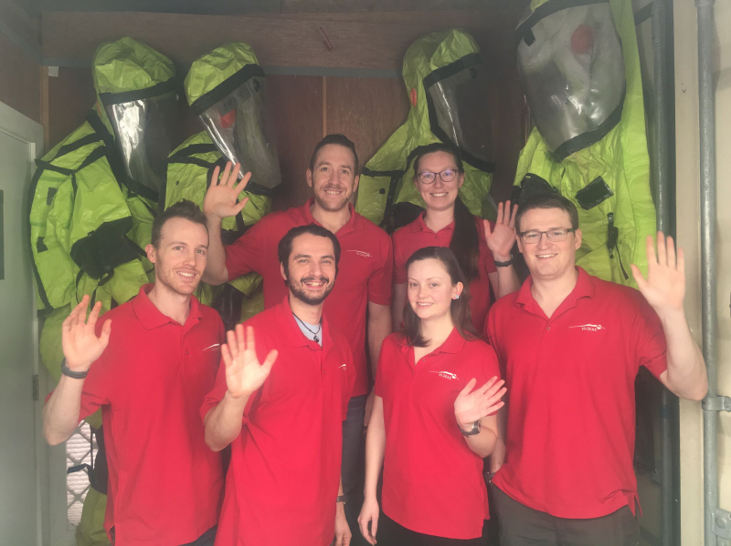Synthetic Biology “on Mars”
— This case study was written in collaboration with James Bevington, Commander of Mission V at HI-SEAS, a NASA-funded 8-month Mars analog isolation mission that began in January and recently ended on September 17th, 2017. The crew of six shared a geodesic dome atop Mauna Loa in Hawaii as a research study designed to better understand the psychological impacts a long-term space mission would have on astronauts.
Fun fact: When we interviewed James via email during his mission, emails were delivered with a 20 minute delay — just as would be experienced on Mars!
Mission to Mars
For centuries Mars has seemed unreachable for humans, but space agencies like NASA are now making plans for manned missions to Mars. The red planet would be the most isolated place humans have ever been to. It would take 6 months or longer to return to Earth from Mars, and because of this long duration, crews on Mars need to be self-sufficient and capable of adapting to unexpected needs. For example, the harsh radiation on the surface of Mars alone will rapidly degrade complex biologicals such as medicines brought from Earth. Synthetic biology promises to help overcome some of these challenges, by using only the basic building blocks of biology to produce a variety of medicines, enzymes, and fuels necessary to sustain a prolonged Mars mission.

Recreating Mars on a Hawaiian volcano
Researcher James Bevington is currently participating in HI-SEAS (Hawaii Space Exploration Analog and Simulation), an eight-month simulated mission to Mars on the slopes of Mauna Loa, in Hawaii. Mauna Loa is a remote location with geological features similar to those found on Mars, such as barren lava fields and underground lava tubes. The crew of 6 consists of scientists, engineers, and pilots who can only communicate with the outside world via a 20 minute transmission delay, experiencing the isolation humans would suffer from on the red planet. Because of this, the crew needs to be mostly independent in ways not normally experienced on Earth. Their small, solar powered habitat has a kitchen, lab, bathroom, living quarters, and 2 small windows. When venturing outside for EVAs (extravehicular activities), the crew wears mock space suits to simulate the inhibited mobility and visibility of a real spacesuit that would protect them from the low temperature, thin atmosphere, and absence of oxygen on Mars.

Synthetic biology in isolation
In order to develop bioengineering capabilities needed for a Mars mission, Bevington set out to perform synthetic biology in the HI-SEAS habitat. He operates out of a lab similar to that of the International Space Station. After hearing about miniPCR at SynBioBeta in 2013, he understood that miniPCR could help him carry out molecular experiments in this extreme environment. Bevington is now building a workflow to assemble artificial DNA molecules that can enable expression and purification of proteins on demand aboard the HI-SEAS habitat. As proof of concept, Bevington is using miniPCR to amplify a red fluorescent protein reporter and carry out a Golden Gate (GG) reaction to insert it into a vector adding a purification tag. GG is superior to other methods in that it allows for simultaneous cloning of multiple DNA fragments into a single recombinant molecule.

Bevington uses a blueGel electrophoresis system to purify the PCR and vector products prior to their assembly into a seamless new molecule. James highlights how blueGel’s safe visible light allows him to visualize the DNA without the risk of degradation posed by ultraviolet light transilluminators.
“When I first discovered miniPCR, I was excited to see how compact and simple it was.”
James Bevington, Researcher, Mauna Loa, Hawaii
Conclusion and future prospects
As Bevington continues on his experiments, he will work towards creating synthetic biology products that are highly functional and useful for medicinal purposes from a very simple setup. With more and more simulated missions to Mars will come more information on what is needed for a successful manned trip to the red planet. The use of synthetic biology may prove essential for such a mission, and Bevington’s experiment is one of the first completed in a simulated Mars environment. As the mission comes to a close, James will focus on demonstrating the workflow and documenting the changes he made to the usual setup to accommodate the limited lab. Synthetic biology still has challenges to overcome before it starts making tangible impacts, but Bevington believes that the field has the “potential to solve most of the world’s most challenging problems such as food, water, and power demand.”
— Read more on James’ blog
— Watch video of the HI-SEAS V crew emerging from their mission (via University of Hawaii)










